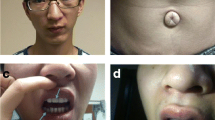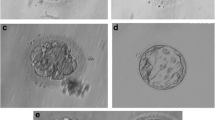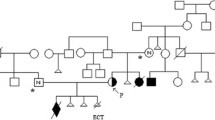Abstract
Backgrounds
While XXY aneuploidy is the most common disorder of sex chromosomes in men, complex chromosomal rearrangements (CCRs) are rare in humans.
Case description
Here we describe clinical and cytogenetic findings in a male referred to our cytogenetic laboratory by an infertility clinic. The patient’s age was 35 at the time of referral. Total azoospermia was confirmed on semen analysis.
Results
The karyotype of peripheral blood showed 47,XXY,t(1;3;5)(p22;q29;q22). The mother had the same CCRs.
Discussion
To our best of our knowledge this is the first case of 47,XXY with CCRs. We think it is important to report such a unique chromosomal occurrence.



Similar content being viewed by others
References
Giardino D, Corti C, Ballarati L, Colombo D, Sala E, Villa N, et al. De novo balanced chromosome rearrangements in prenatal diagnosis. Prenat Diagn. 2009;29:257–65.
Gorski JL, Kistenmacher ML, Punnett HH, Zackai EH, Emanuel BS. Reproductive risks for carriers of complex chromosome rearrangements: analysis of 25 families. Am J Med Genet. 1988;29:247–61.
Batanian JR, Eswara MS. De novo apparently balanced complex chromosomes rearrangement (CCR) involving chromosome 4, 18, and 21 in a girl with mental retardation: report and review. Am J Med Genet. 1998;78:44–51.
Batista DA, Pai GS, Stetten G. Molecular analysis of a complex chromosomal rearrangement and a review of familial cases. Am J Med Genet. 1994;53(3):255–63.
Gruchy N, Barreau M, Kessler K, Gourdier D, Leporrier N. A paternally transmitted complex chromosomal rearrangement (CCR) involving chromosomes 2, 6, and 18 includes eight breakpoints and five insertional translocations ITs) through three generations. Am J Med Genet. 2009;152:185–90.
Patsalis PC. Complex chromosomal rearrangements. Genet Couns. 2007;18(1):57–69.
Kousseff BG, Nichols P, Essig YP, Miller K, Weiss A, Tedesco TA. Complex chromosome rearrangements and congenital anomalies. Am J Med Genet. 1987;26:771–82.
Kausch K, Haaf T, Kohler J, Schmid M. Complex chromosomal rearrangement in a woman with multiple miscarriages. Am J Med Genet. 1988;31:415–20.
Zahed L, Der Kaloustian V, Batanian JR. Familial complex chromosome rearrangement giving rise to balanced and unbalanced recombination products. Am J Med Genet. 1998;79:30–4.
Houge G, Liehr T, Schoumaps J, Ness GO, Solland K, Starke H, et al. Ten years follow up of a boy with a complex chromosomal rearrangement: going from a >5 to 15-breakpoint CCR. Am J Med Genet. 2003;118:235–40.
Juchniuk de Vozzi MS, Santos SA, Pereira CS, Cuzzi JF, Laureano LAF, Franco Jr JG, et al. Meiotic segregaion and inerchromosomal effect in the sperm of a double translocation carrier: a case report. Molec Cytogenet. 2009;2:24–9.
Abramsky L, Chapple J. 47, XXY (Klinefelter syndrome) and 47, XYY: estimated rates of and indication for post-natal diagnosis with implications for prenatal counselling. Prenat Diagn. 1997;17:363–8.
Gosden CM, Davidson C, Robertson M. Lymphocyte culture. In: Rooney DE, Czepulkowski BH, editors. Human cytogenetics: a practical approach. Vol I. Constitutional analysis. Oxford: IRL. Press Ltd; 1992. p. 31–54.
Benn PA, Perle MA. Chromosome staining and banding techniques. In: Rooney DE, Czepulkowski BH, editors. Human cytogenetics: a practical approach. Vol I. Constitutional analysis. Oxford: IRL Press Ltd; 1992. p. 91–118.
Shaffer LG, Tommerup N. An International System for Human Cytogenetic Nomenclature (ISCN). Basel: S. Karger; 2005.
Bartels I, Starke H, Argyriou L, Sauter SM, Zoll B, Liehr T. An exceptional complex chromosomal rearrangement (CCR) with eight breakpoints involving four chromosomes (1;3;9;14) in an azoospermic male with normal phenotype. Eur J Med Genet. 2007;50(2):133–8.
García JL, Hernández JM, González M, San Miguel JF, Dal Cin P, Van Den Berghe H. Translocation (15;17) (q22;q21) in a patient with Klinefelter syndrome. Cancer Genet Cytogenet. 1996;86(1):86.
Vasu V, Chandra N, Jayashankar M, Santhiya ST. Klinefelter variant mosaic with a reciprocal translocation t(1;7). Fertil Steril. 2008;90(5):2017.e15–2017.e17.
Gül D, Sayli BS. Klinefelter syndrome associated with 13/14 translocation abnormality 46, XXY, t(13q;14q). Urol Int. 1994;52(3):166–8.
Sparagana M, Smith GP. Klinefelter’s syndrome associated with a D/D translocation. J Med Genet. 1975;12(3):299–301.
Waldenmaier C, Hirsch W, König E, Shibata K. Identification of a 18–21 translocation with Klinefelter's syndrome by G-band patterns. Humangenetik. 1974;21(4):323–9.
Dumars KW, Reed P, Lawce HJ. X-autosome translocation with a 47, XXXY qs, t(9p-;Xq+) karyotype. Birth Defects Orig Artic Ser. 1975;11(5):247–53.
Lee Iw, Su MT, Hsu CC, YH L, Chen Py, Kuo PL. Constitutional complex chromosomal rearrangements in azoospermic men--case report and literature review. Urology. 2006;68(6):1343.e5–1343.e8.
Cai T, Yu P, Talge D, Lu D, Chen Y, Xia J. A de novo complex chromosomal rearrangement with a translocation 7;7 and 8q insertion in a male carrier with no infertility. Hum Repr. 2001;1:59–62.
Vanneste E, Voet T, Melotte C, Debrock S, Sermon K, Staessen C, et al. What next for preimplantation geneic screening? High mitotic chromosome instability rate provides the biological basis for the low success rate. Hum Reprod. 2009;11:2679–82.
Joly-Helas G, de La Rochebrochard C, Mousset-Siméon N, Moirot H, Tiercin C, Romana SP, et al. Complex chromosomal rearrangement and intracytoplasmic sperm injection: A Case Report. Hum Reprod. 2007;22(5):1292–7.
Lim CK, Cho JW, Kim JY, Kang IS, Shim SH, Jun JH. A healthy live birth after successful preimplantation genetic diagnosis for carriers of complex chromosome rearrangements. Fertil Steril. 2008;90(5):1680–4.
Author information
Authors and Affiliations
Corresponding author
Additional information
Capsule
The concurrence of complex chromosomal rearrangements (CCRs) with sex chromosome aneuploidy has not been reported before. This is the first report of CCRs with an extra chromosome X in an infertile male.
Rights and permissions
About this article
Cite this article
Mahjoubi, F., Razazian, F. Constitutional complex chromosomal rearrangements in a klinefelter patient: case report and review of literature. J Assist Reprod Genet 29, 437–441 (2012). https://doi.org/10.1007/s10815-012-9725-y
Received:
Accepted:
Published:
Issue Date:
DOI: https://doi.org/10.1007/s10815-012-9725-y




